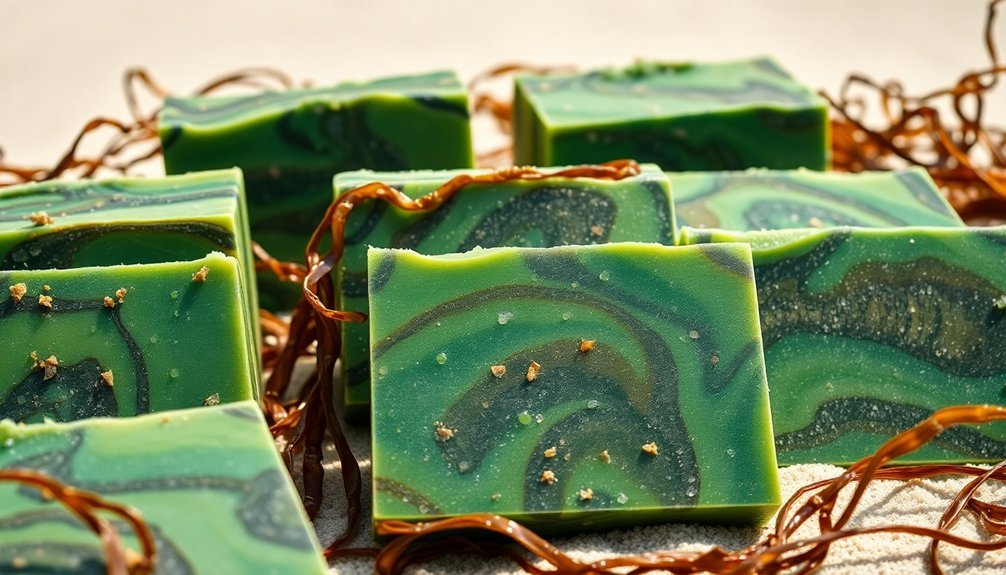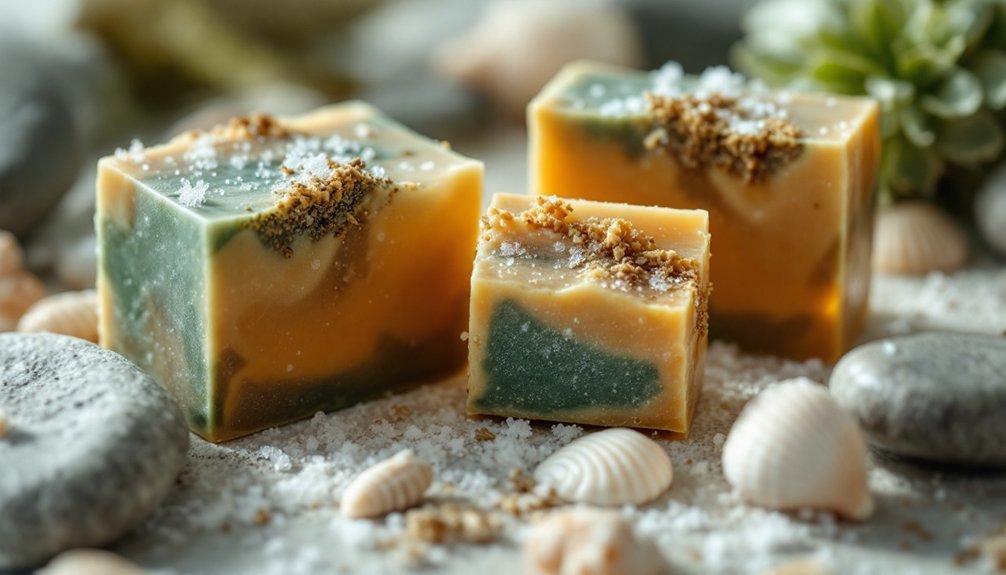For natural exfoliation, try these three ocean-fresh seaweed soaps: 1) Red seaweed (*Gracilaria*) soap for gentle cleansing and antioxidant benefits, 2) Brown seaweed (*Laminaria*) soap for deep nutrient delivery and mineral-rich exfoliation, and 3) Green seaweed (*Caulerpa*) soap for soothing sensitive skin while removing impurities. You'll enjoy their marine aromas while supporting sustainable harvesting practices. Discover how these multicellular algae transform your skincare routine beyond simple cleansing.
Ancient Ocean Botanicals: Seaweed Types and Their Skin Benefits

Treasures from the deep, seaweeds have nourished skin across cultures for centuries.
These marine plants deliver essential vitamins A, B2, B6, and B12 that provide powerful antioxidant protection for your skin.
Three main varieties offer unique benefits in skincare.
Seaweed's trinity of red, brown, and green varieties delivers a spectrum of specialized skincare solutions from the sea.
Red seaweed, including *Gracilaria* and *Porphyra*, has been a staple in Asian skincare traditions.
Brown varieties like *Fucus* and *Laminaria* deliver exceptional nutrient profiles, making them ideal for nourishing formulations.
Green seaweed, such as *Caulerpa*, rounds out the spectrum with its own beneficial properties.
What makes seaweed exceptional for your skin?
Beyond vitamins, it's packed with minerals like potassium, zinc, and iron while offering gentle exfoliation and anti-inflammatory effects to soothe sensitivity and redness.
Seaweed consists of several multicellular algae groups forming a polyphyletic group with diverse beneficial properties for skin health.
Crafting the Perfect Seaweed Soap: Step-by-Step Recipe Guide
After discovering the skin-nourishing benefits of seaweed, you'll want to try creating your own marine-infused cleansers at home.
Start by selecting dried seaweed from Asian markets or beach-harvested varieties to prevent mold in your soap.
For beginners, try the melt-and-pour method—no lye handling required. Simply melt the base, add powdered seaweed, and pour into molds. Spray the poured soap with rubbing alcohol to eliminate air bubbles on the surface.
If you're more adventurous, cold process soap offers greater customization but requires safety gear when working with lye.
Blend olive, coconut, and castor oils for moisture, then incorporate seaweed powder at trace.
Consider adding complementary scents like lavender or rosemary to balance the marine aroma. For extra exfoliation, sprinkle in sea salt—but don't overdo it.
Allow cold process soaps to cure for several weeks before enjoying your ocean-fresh creation.
Eco-Friendly Exfoliation: Sustainable Harvesting Practices for Seaweed Soaps

While enjoying the benefits of seaweed soap, you're also participating in a crucial ecological choice. Sustainable harvesting methods guarantee your skincare doesn't harm marine ecosystems.
Hand harvesting stands out as the most eco-friendly approach—selective cutting preserves the essential holdfast and maintains at least 75% of local biomass. This careful technique supports carbon sequestration and marine biodiversity while the seaweed regrows. Resource managers use satellite technology and field monitoring to ensure harvesting practices remain sustainable and minimize ecosystem impact.
Look for products that follow rotation systems and harvest during peak seasons. Companies adhering to third-party sustainability standards often track their environmental impact and engage local communities.
As demand for natural exfoliants rises, supporting businesses that practice sustainable harvesting helps protect our oceans while you benefit from seaweed's natural exfoliating properties.
Frequently Asked Questions
Does Seaweed Soap Have a Strong Ocean Smell?
Most seaweed soaps don't have a strong ocean smell. You'll typically experience light, beachy fragrances with floral notes or fresh scents instead, as manufacturers use essential oils to create pleasant, subtle aromas.
How Long Does Homemade Seaweed Soap Typically Last?
Your homemade seaweed soap typically lasts 6-12 months when stored properly. You'll get maximum shelf life by keeping it in a cool, dry place away from direct sunlight and humidity.
Can Seaweed Soap Be Used on Sensitive or Acne-Prone Skin?
Yes, seaweed soap is excellent for sensitive and acne-prone skin. It's gentle, maintains pH balance, and contains minerals that soothe inflammation. You'll appreciate its detoxifying properties that help reduce oil production and clear acne.
Will Seaweed Soap Stain My Washcloth or Shower?
Seaweed soap typically won't stain your washcloths or shower. Rinse thoroughly after use to prevent any residue buildup. Darker colored washcloths are a good option if you're concerned about potential discoloration.
How Often Should Seaweed Soap Be Used for Optimal Results?
You should use seaweed soap daily for normal to oily skin, but limit to 2-3 times weekly if you're exfoliating or have sensitive skin. Always adjust based on your skin's response and the product's guidelines.
In Summary
You'll notice the difference in your skin immediately with these ocean-fresh seaweed soaps. They're not just exfoliating—they're delivering minerals and antioxidants directly to your skin. By choosing sustainably harvested seaweed products, you're caring for your skin and our oceans simultaneously. Give these DIY recipes a try, and you'll transform your daily cleansing routine into a rejuvenating spa experience that honors ancient skincare wisdom.





Leave a Reply